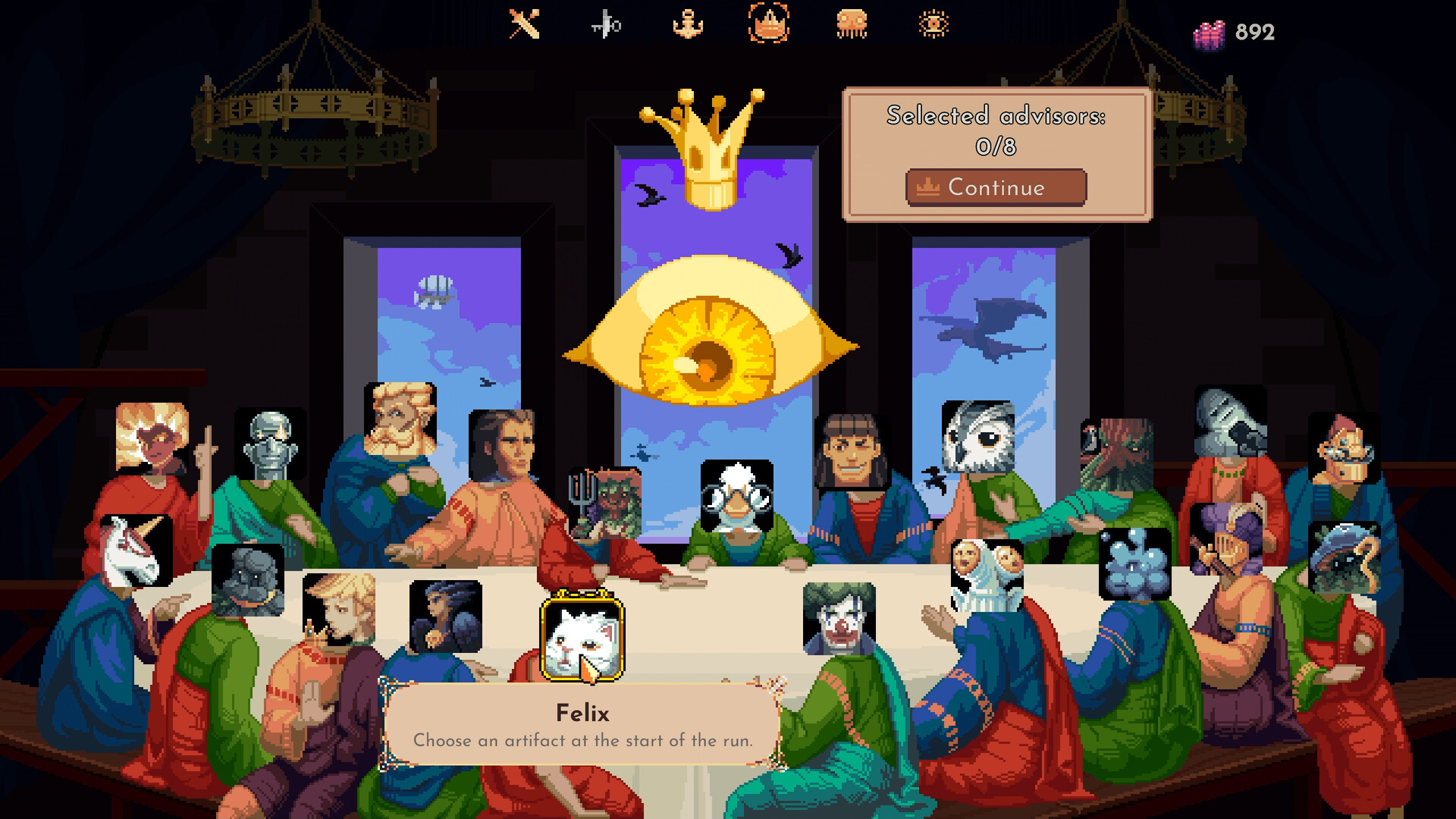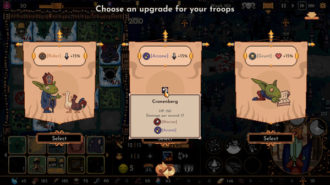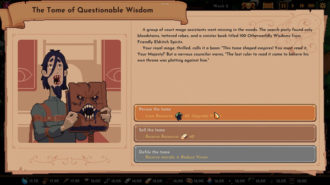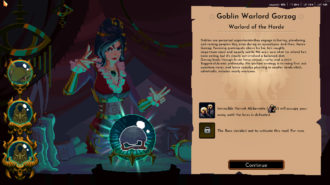Platform:
PC
Released:
July 21, 2025
Publisher:
tinyBuild Games
Developer:
Hypnohead
Roguelikes and roguelites feel like an indie release staple at this point. Coined from the 1980 release of Rogue, the rise of small game studios, digital distribution, and the success of hits like Spelunky and Slay the Spire have seen a growing cornucopia of roguey releases for players to choose from. This year alone has already seen Blue Prince and Monster Train 2 sparking early GOTY conversations alongside other solid titles like Lost in Random: The Eternal Die, Luck be a Landlord, Rift Wizard 2 and Caves of Qud 1.0. We also can’t forget the godlike silhouette of Hades II‘s 1.0 release likely later this year. All of this suggests a genre overflowing with innovation and surprise, but also one that may be risking oversaturation.
Into this glut comes The King is Watching. The King is Watching is a roguelite city builder developed by Hypnohead and published by tinyBuild. It sees the player take on the role of ruler in a dark fantasy setting who must build their kingdom, collect resources and repel invaders, trying to survive as long as possible before being defeated and trying again. The King is Watching’s core mechanic is its gaze – channeling the mindset of your most hated former boss, only buildings that the king oversees actually work. From moment to moment, the player must choose between producing resources and training armies while enemies intermittently arrive at your city gates seeking to end your run and return you battered and bruised back to the title screen.
This is the third roguelike I’ve reviewed for Checkpoint this year, following the excellent Monster Train 2 and Against the Storm, and The King is Watching follows in their footsteps to offer an interesting new take on the genre. Its core gaze mechanic is a novel one that embodies the old real-time strategy meme of ‘the cursor is back, act busy!’ and encourages a new way of (appropriately) looking at city building that focuses more on placement and tile variety. However, against the tide of other stellar roguelikes from both this year and beyond, The King is Watching cannot help but stumble slightly into homogeneity. Despite its strengths, a lack of extensive run variety and uneven meta-progression makes this a solid but unexceptional addition to my roguetation. Given the glut of genre compatriots out there, that isn’t quite enough to stand out.
“…against the tide of other stellar roguelikes from both this year and beyond, The King is Watching cannot help but stumble slightly into homogeneity.”
Let’s start with The King is Watching’s titular watching. Across runs, players are given a randomised assortment of spells, tiles, barracks and more that they must fit into a five-by-five kingdom grid. Your gaze typically starts as only three tiles large, though this can be upgraded as runs progress, meaning what you focus on particularly early on is crucial. This core gameplay rhythm of choosing what your kingdom works on, shuffling around your city’s infrastructure and gaining increasingly powerful tiles is ultimately a very satisfying one. I found it quite zen getting home after a long day and settling into a steady groove of repeated runs while listening to podcasts (given the in-game score gets repetitive a bit too fast). There is a tetris-like level of satisfaction to be had fitting the right tiles into the right places to maximise efficiency.
However, these runs began to feel familiar quite quickly, which is not a minor issue for a game genre defined by repetition. Compared to Monster Train 2 which has such a dizzying array of mechanics as to feel near overwhelming, I quickly found myself encountering the same enemies, artifacts, choices and bosses quite quickly. Only two bosses per phase per biome exist, meaning it became easy to guess what I would be dealing with quite early on. Even though my troop composition did vary plenty between runs, given the troops auto-battled their material impact on each run was negligible, changing little more than how long I needed to spend watching a particular building. This meant that, once I had settled on a few working strategies several runs in, very little motivated me to change.
The only modifier big enough to knock me onto a different course was my choice of king. There are six to choose from and each comes with three different abilities and three different quests that offer various bonuses if accomplished each run. Choosing the king that loved raising troops from the dead, or the one that slings spells left and right, happily incentivised me to change up my approach for at least a run or two, and often to great success. Each king also has a separate tree of gaze unlocks, meaning that not only do their abilities feel distinctive, they fundamentally shape how you compose your kingdoms.

Where the kings subsequently flounder, however, is how they fit into The King is Watching’s uneven meta-progression. Meta-progression, the type of progression in roguelites that helps make each run a little easier, is the personal bedrock of my love of so many classics of the genre like Hades or Vampire Survivors. However, in The King is Watching, meta-progression feels both a tad slow and unbalanced. A lot of this stems from the game’s dual currencies; coins that you get a handful of each run and crystals which you only get by completing a run at a certain difficulty for the first time or by completing specific challenges.
While a lot of early upgrades can be purchased with just the former, many upgrades require both, including the aforementioned kings that vary up replayability. This meant a lot of my early game was spent struggling through initial runs buying small incremental upgrades only to see the needle move only slightly, while the bigger game-changing unlocks felt far too out of reach. This issue is compounded by the unevenness of these upgrades, with some feeling absolutely essential and others, particularly the glut of unlockable advisors, remaining incidental curiosities at best. Possibly self-aware evidence of this stilted non-linear progression was the fact that, for review, I was provided a save file that came with several kings unlocked and enough currency to buy most upgrades. This was fantastic while reviewing, and indeed something more developers should offer more for time-poor media, but my first handful of hours before I used it made me worry about the average person who buys the game and doesn’t have the option to jump over many of its initial hurdles. I suspect The King is Watching would lose its lustre much more quickly in those circumstances.
The King is Watching’s presentation is otherwise great. It has a very familiar but nonetheless effective pixel-art style and shows some real creativity with the range of buildings and troops it contains, particularly when it leans into the dark fantasy elements of its setting. Never in a game did I expect to have madmen who befuddle their enemies to fight alongside the likes of demonic black rams and multi-headed geese hydra. The King is Watching also contains some scant narrative framing in the form of short painterly interludes that unlock intermittently. While they inevitably feel too minor to really shape the player’s experience, they were nonetheless a highlight whenever I stumbled across one, and speaks nicely to how effective The King is Watching was when its setting was used to full gothic effect.
While I have admonished The King is Watching plenty in this review, I want to briefly conclude by reiterating that this game’s core remained engaging over my time reviewing it. While it does lack variety, especially when standing in the shadows of titans like Monster Train 2, The King is Watching still gets at one of the other core appeals of roguelikes – repetition, and the comforting familiarity and mastery it can elicit. It feels strange to call a gothic fantasy roguelike with a neoliberal late-stage-capitalist hook ‘comforting’, but that was the feeling I was left with most often during play. While I was left frustrated with its lack of variety and uneven progression, at the centre of its crown The King is Watching is still a pleasantly designed roguelike that makes a solid royal decree for your attention. Whether that is enough to stand out amongst the crowd, however, is a more difficult question to answer.
7.5
Good
Positive:
- Satisfying and simple central hook
- Creative use of its setting
- Soothingly straightforward runs
Negative:
- Unbalanced and stitled meta-progression
- Not quite enough variety over dozens of runs
The King is Watching is a satisfying, if slightly homogeneous, tetris-like roguelite base builder. While it struggles a bit with variety and uneven meta-progression, its gaze mechanic is a simple and clean hook that, alongside a creative setting and range of kings, makes for an almost comforting building manager run after run. The only problem is, that may not be enough to steal player’s gaze away from the wealth of other roguelikes it’s competing with this year.











